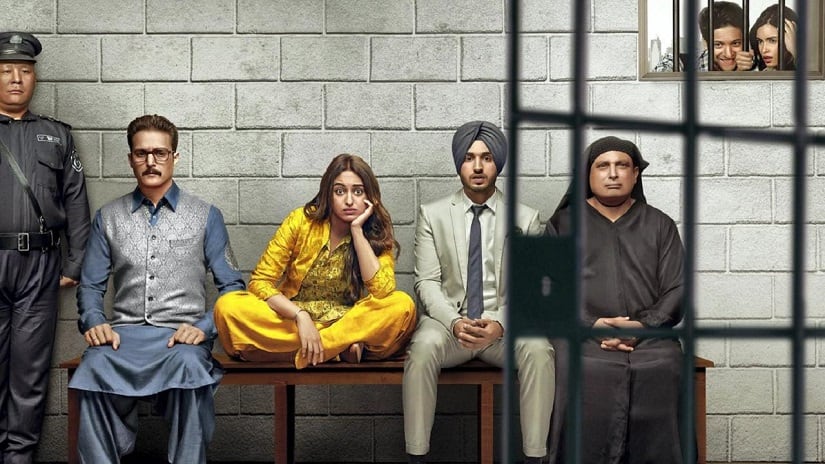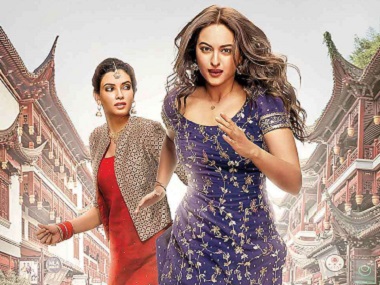Every month or so, a few classmates and I would go to a cheap theatre near college and watch a Hindi movie we wouldn’t — or perhaps shouldn’t — otherwise pay to watch. It was a ritual not always observed while sober, and the movie would have to be particularly not intelligent, for want of a better description. College ended a couple of years ago, which makes this movie ritual — something that has exposed me to gems like Humshakals and Phantom — rather dated. So when a colleague recently suggested we go for Happy Phirr Bhag Jayegi instead of all the other films I had proposed, there was no contest. As they say after a good meal at Hotel Ram Ashraya in Matunga East, the experience of watching Happy Phirr Bhag Jayegi was indeed paisa vasool. From a visibly uninterested Piyush Mishra calling Denzel Smith ‘Kaancha Cheena’ because he looked like Danny Dengzongpa, to Jimmy Sheirgill’s character saying, “Agar tu Gill hai, taa main Sheirgill hoon” — the movie gave me what I sought. A juvenile plot, senseless dialogues, terribly written characters and perhaps a reason to question my life decisions — just a few of my favourite things, as Julie Andrews might say. **Also read:** Happy Phirr Bhag Jayegi movie review: Sonakshi Sinha leads charge with gusto in a pleasantly silly comedy However, what I didn’t buy my ticket for, was the embarrassingly ill-disguised xenophobia and consistent, tasteless racism. [caption id=“attachment_5096831” align=“alignnone” width=“825”]  Still from Happy Phirr Bhag Jayegi[/caption] But first, some context. Here’s a short summary of the movie’s plot: A policeman from Lahore, a groom from Punjab (the Indian Punjab), a lady teaching horticulture from the same state, and an officer in the Indian embassy get involved in a wild goose chase set in Shanghai. Yes, Shanghai doesn’t even host the Indian embassy (it has a consulate), but I digress. With the story set in China, there were obviously a lot of East Asian stereotypes in store. From noodle boxes in everyone’s hands to repeated dialogues about how everyone in the city “looks the same”, director Mudassar Aziz pushed out a stereotype every other minute. But it got confusing when even the stereotypes started firing in the wrong directions, geographically. At the very beginning of the film, Five Spice-restaurant-music disguised as a Shaolin-score started playing in the background. I look up at the screen to see that some supposedly Chinese students have mistaken another lady for the horticulture professor, and suddenly this other lady has to speak to a crowd about Bonsai cultivation techniques. It clearly didn’t matter that Bonsai was a Japanese art form. The misdirected stereotypes continued long into the film’s run time, and after a point, it seemed like the second episode of Sacha Baron Cohen’s Who is America, where US politician Jason Spencer said the following words when asked to pretend to be a Chinese tourist: “Konnichiwa, Red Dragon, Beijing, Hong Kong, Sushi, Ho Chi Minh City, Red Dragon, chopsticks.” At least a couple of those words were bound to turn out accurate. But the line was crossed in an entirely separate scene. When a hallucinating Piyush Mishra joins the ‘Indian’ characters to complain (again) about how all Chinese look identical, director Aziz actually decided to temporarily cast (the same) Jason Tham as different characters in a crowded road — illustrating that screenplay should not fall behind a movie’s dialogues when it comes to racism. It would, however, be foolish to isolate this one movie when most of the Indian film industry is still yet to get over its obsession with something like fair skin — and more than that, its collective abomination of dark skin. From Chennai Express to Fashion, movies made by both big and small filmmakers, have linked dark skin to something undesired, if not evil. It seldom matters if the dark-skinned character is Senegalese or a Tamilian. When the iconic ‘Hum kaale hai toh kya hua, hum dilwale hai’ from the 1965 flick Gumnaam insisted that even a dark-skinned person can be large-hearted, it set the tone for what followed in Bollywood. But times have changed since then, and with the increasing dialogue around caste and race around the world, popular culture has also been forced to change its antediluvian ways. So when a Raman Raghav 2.0 shows Vicky Kaushal going to a Black man to get his fix of cocaine, it needs to be called out. When a Happy Phirr Bhag Jayegi names a character Fa Kyu to make it somehow sound Chinese, it needs to be called out. There is nothing inherently wrong with a loose interpretation of the word ‘entertainment’, especially in Bollywood where cinema is so often a tool for people to unwind. The market for movies with silly plots and dialogues inspired from WhatsApp jokes is a thriving one in India, and is here to stay. But it cannot come at the cost of blatant racism, or even sexism — not in 2018. The writer never writes on movies and is proud to have not played the Being-from-Assam card in an article on racism in India.
In Bollywood, it’s racism — swaad anusar.
Advertisement
End of Article


)
)
)
)
)
)
)
)
)



